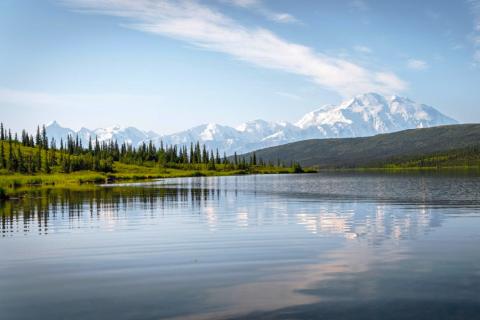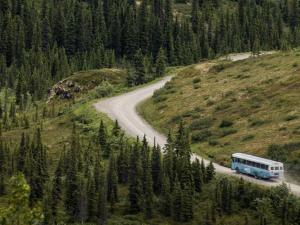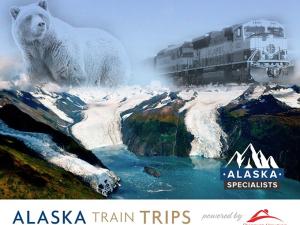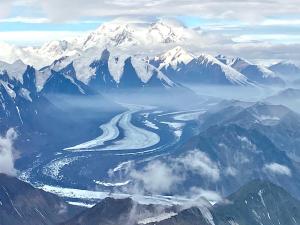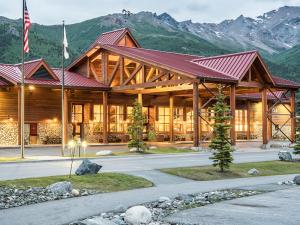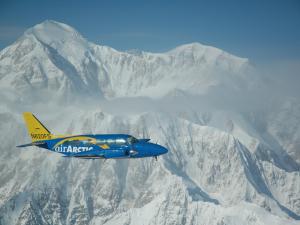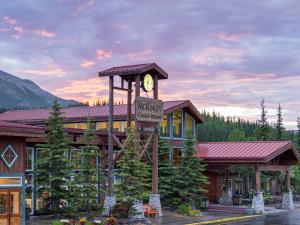Denali National Park and Preserve
Magnificent wildlife, vast tundra, and the towering Denali are highlights of this world-famous national park.
The granite peaks and snowy summits of Denali National Park and Preserve cover 160 miles of the Alaska Range and are so tall they are often lost in the clouds. Dominating this stunning landscape is Denali - the highest peak in North America. Denali majestically ascends 20,310 feet and is one of the most awe-inspiring sights in Alaska. The Denali area is the traditional homeland of the Koyukon Athabascan people, who named the mountain Denali, meaning "the Great One," and revered it as a sacred place.
Most visitors come to the park between mid-May and early September, when park bus tours are operating and wildlife viewing is at its best. You'll find the majority of the park's visitor services at the entrance to the park, including the Riley Creek Campground, the Alaska Railroad station, two visitor centers, hiking trails, and the Denali Bus Depot, which serves as the park's transport hub and campground reservation center. From the park's entrance, the 92-mile Park Road heads west through the heart of Denali, passing Eielson Visitor Center and five backcountry campgrounds including Wonder Lake Campground, where on a clear day campers enjoy a reflection of Denali on the mirrored surface of the lake. The road ends at the old mining settlement of Kantishna, now the site of several wilderness lodges. The Park Road is only open to personal vehicles until mile 15, making Denali bus tours one of the best ways to experience the park, and one of the most popular national park tours in Alaska.
A note for visitors from 2024 - 2026:
The Denali Park Road will be open until mile 43 through 2026 due to road improvements. Narrated bus tours and transit buses will continue to be available for guests visiting the park and will travel as far as mile 43. The main visitor center will remain open along with four campgrounds and numerous trails accessible via the Park Road. Please check with Kantishna-area businesses about their operational plans for lodging and excursions through 2026. Free shuttle bus service will run every 15 minutes during peak visitation times between the Denali Bus Depot / Denali Visitor Center to the Mountain Vista and Savage River Trailheads. The Denali Park Road Lottery will not be offered during this time.

Things to Do in Denali National Park
Visitor Centers
Located just inside the park's entrance are two visitor centers that serve as hubs of information and resources for the park. The Denali Visitor Center is a 14,000-square-foot facility with interactive exhibits and rangers to answer your questions about the park. On the first floor are exhibits devoted to the area's natural and human history and a theater with a movie that provides a glimpse of the park's wildlife and scenery. On the second floor is a giant table-top relief map that illustrates the vast and rugged landscape of the park. The Murie Science and Learning Center features fascinating hands-on exhibits as well as a display on research currently taking place in the park. The staff stages nature-related programs throughout the week during the summer. The Murie Science and Learning Center also serves as the main visitor center in winter, from October through April.
Located at Mile 66 of the Park Road, the Eielson Visitor Center is Denali National Park's most impressive interpretive center. The 7,400-square-foot facility features exhibits on the natural history of the region, a massive model of Denali, and huge viewing windows to see North America's highest peak. The only way to reach the Eielson Visitor Center is on a bus tour of the park.
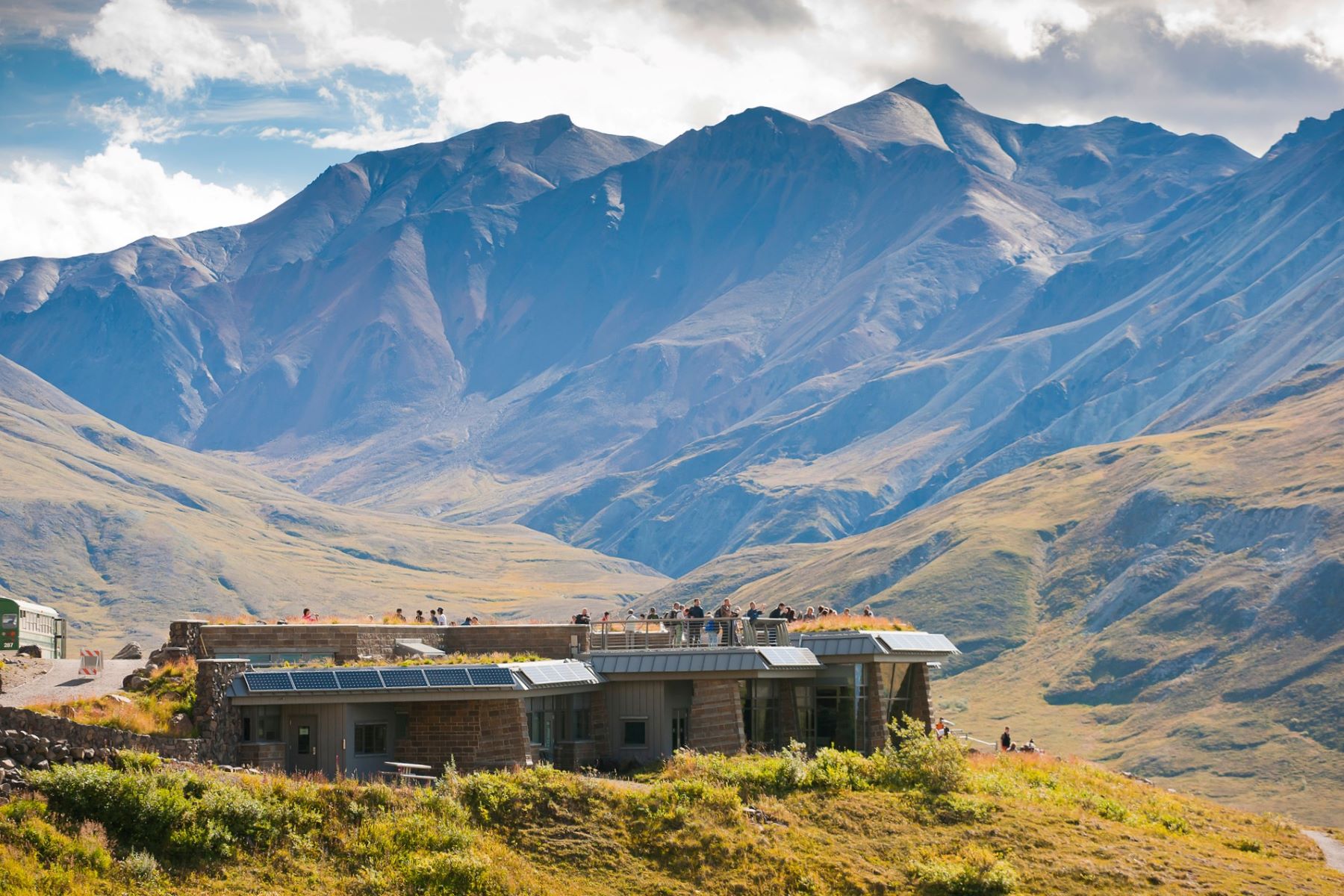
Denali Bus Tours
The majority of the 92-mile Park Road that leads into the heart of the park is not open to private vehicles, so the best way to explore the park is by bus. There are two types of buses into the park: narrated tour buses and non-narrated transit buses.The Natural History Tour and the Tundra Wilderness Tour busses are narrated by onboard naturalists and take you to the top sightseeing spots, pausing for wildlife viewing along the way. Half-day and full-day options are available depending on how far you want to travel along the road. Visitors are encouraged to make reservations for Denali National Park bus tours in advance and check the Denali National Park website for up-to-date visitor information.
Transit buses are hop-on, hop-off and are designed for campers and hikers who want a more independent experience of the park. These buses are cheaper and do not include narration. Day hikers can get off the bus anywhere along the Park Road and at the end of their trek can flag down any bus for a ride back to the park entrance. There are also free buses that follow a circuit through the park entrance area and out to Savage River at mile 15 of the Park Road.
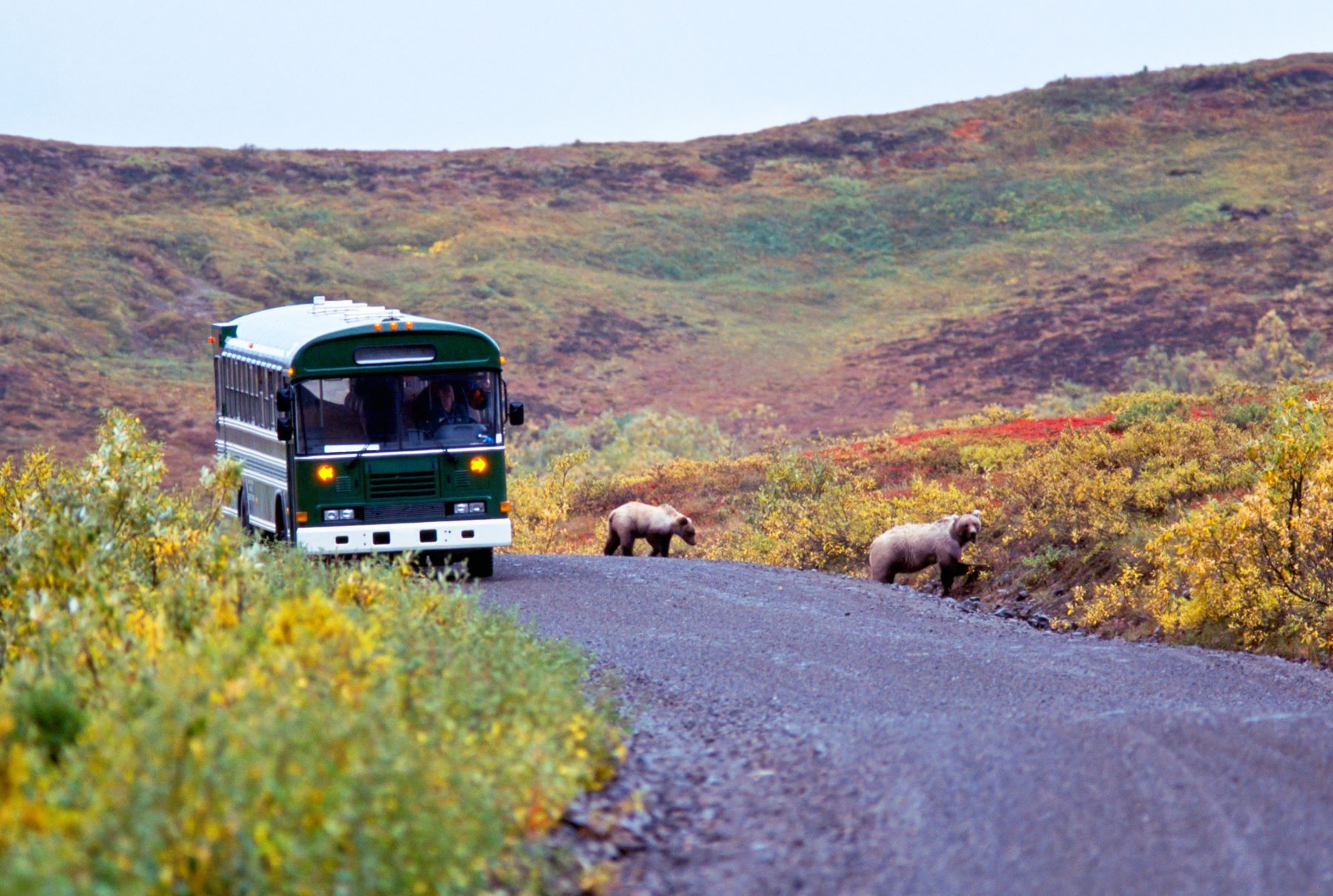
Wildlife viewing
It’s not just the mountain that makes Denali National Park such a special place. Most visitors come to see Alaska's "Big Five": bears, moose, caribou, wolves, and Dall sheep - all of which can be seen in the park. Grizzly bears are mainly seen on the open tundra while black bears inhabit forested areas of the park. Most of the bears seen by visitors along the Park Road are grizzlies. Denali is one of the best places in the world to view wolves in the wild, though sightings are unpredictable, based on locations of wolf dens from year to year. Sightings of moose, caribou, and Dall sheep are very common. The park is home to a total of 39 species of mammals, including lynx, marmots, Arctic ground squirrels, foxes, and snowshoe hares, along with 130 different bird species - making wildlife viewing in the park a thrilling and spectacular experience.
Unlike most wilderness areas in the country, you don't have to be a backpacker for the best chances to see wildlife. Everyone who visits the park has excellent opportunities to view these amazing creatures roaming free in their natural habitat, with narrated bus tours offering some of the best opportunities for wildlife viewing in the park. The buses’ naturalist guides are experts at spotting wildlife and will provide ample time for wildlife viewing stops along the way.
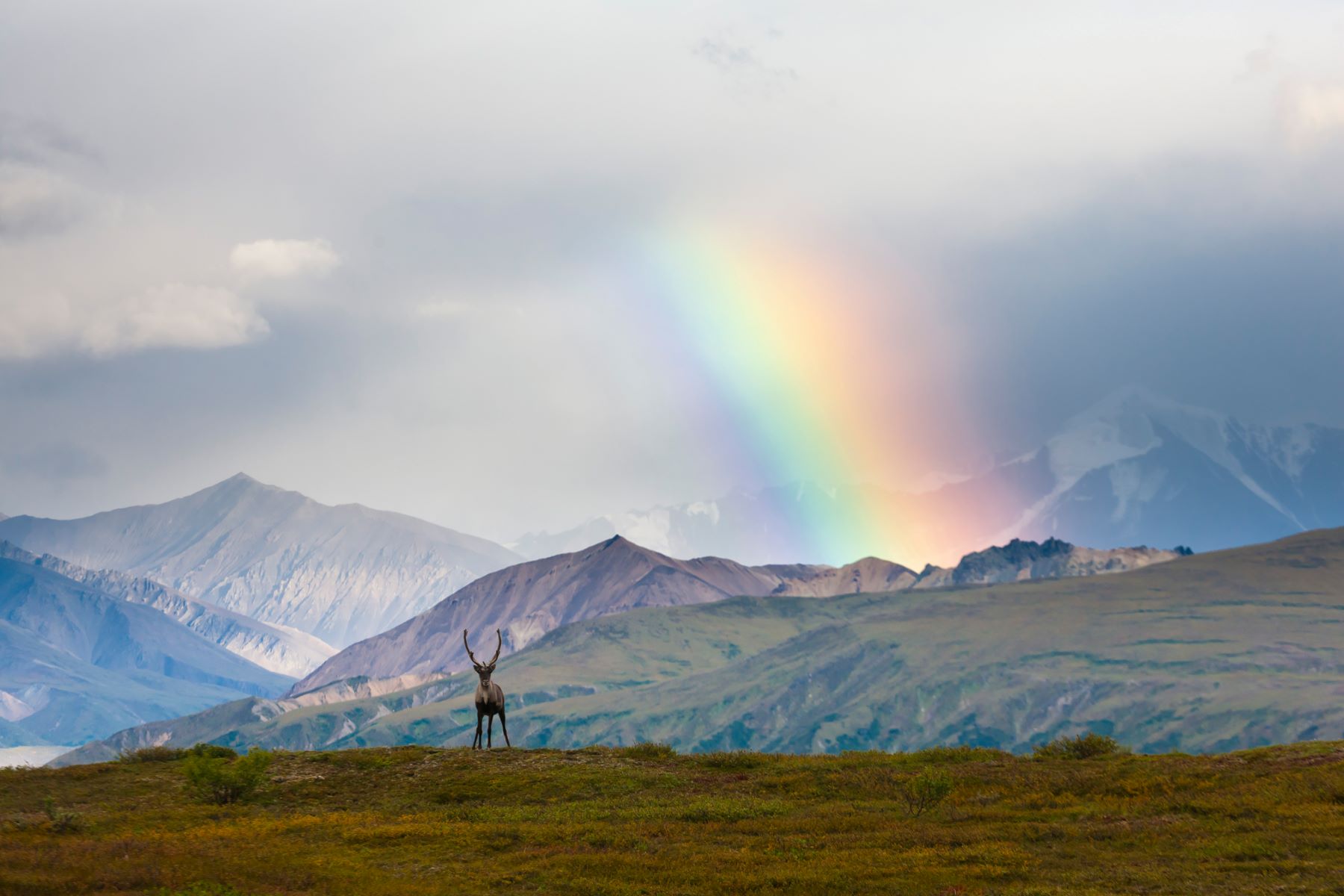
Hiking & Backpacking
The park's vast wilderness area is home to relatively few designated hiking trails, most of which are located near the park's entrance. Within a couple miles of the Denali Visitor Center are eight trails with various difficulty that explore the lakes, rivers, and alpine scenery around the park entrance. Popular hikes near the park entrance include the Horseshoe Lake Trail and Mt. Healy Overlook Trail. The Savage River Area, located at mile 15 of the park road, is home to two other popular hikes: the Savage River Trail, a flat loop trail along the scenic Savage River; and the Savage Alpine Trail, which climbs steeply from Savage River for sweeping views of the surrounding landscape. Additional designated hiking trails can be found along the Park Road at the Eielson Visitor Center and Wonder Lake. Learn more about designated hiking trails in Denali.
For many, Denali offers the opportunity to escape into the backcountry for a true Alaska wilderness experience. Thanks to Denali's rigid restrictions and permits, backpackers can trek and camp in a slice of wilderness all their own, even if it's just for a couple of days. Since the park has few designated hiking trails, the main way to explore on foot is by backcountry hiking over open terrain such as gravel riverbeds and tundra ridges. Visitors interested in overnight backpacking trips can obtain a free backcountry permit the day before their trip. In order to prevent overuse, the park is divided into 87 units and only a certain number of permits are allocated to each unit per day. Park rangers will help you select your backcountry unit when you apply for your permit the day before your trip.

Biking
The Denali Park Road is open to adventurous cyclists who are interested in a day biking trip or overnight bikepacking trip. Biking the Denali Park Road is challenging and requires careful planning and attention to safety, but rewards with stunning views and access to Denali's backcountry. The Park Road is unpaved and has no shoulders. Cyclists share the road with park buses and should always be aware of their surroundings to let buses and other vehicles pass. Bears and other wildlife are frequently seen along the Park Road and cyclists must respect wildlife and be aware of bear safety. Bikes can be transported on transit buses for access further into the park - but advance reservations are recommended to ensure that there is space for your bike.
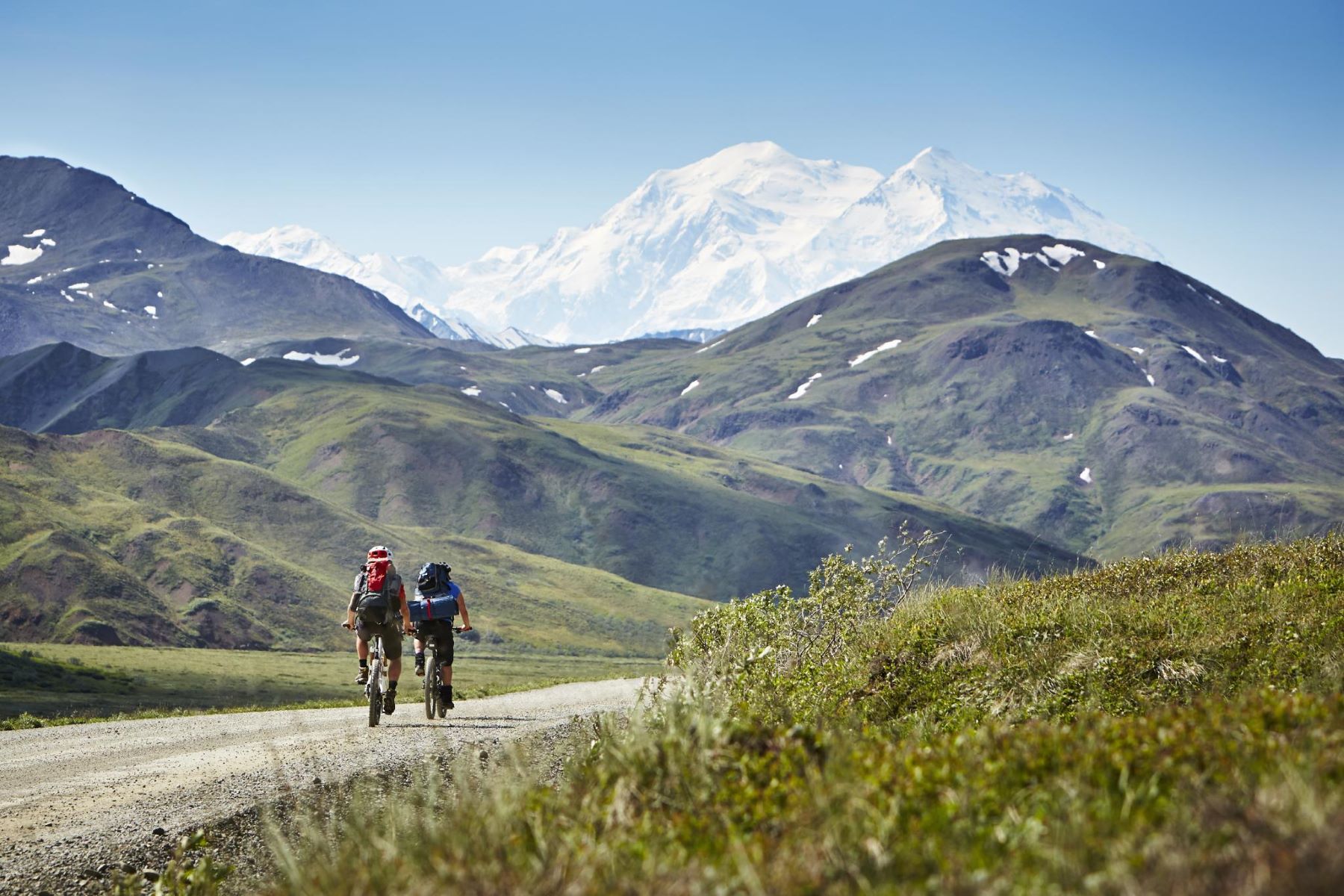
Adventure Tours
A visit to Alaska is nothing if not adventurous, and adventure tours in Denali take that spirit to the next level. This is the place to indulge in experiences you won’t find anywhere else: take a helicopter or flightseeing tour and land on a glacier. Raft the Nenana River, with its swirling glacier waters roaring through a canyon. Soar across the boreal forest on a zipline. Watch out for wildlife as you navigate creek beds on an ATV tour. All of these tours and more are on offer from operators in Denali Park Village, just outside the Park entrance.

Driving into Denali National Park
Visitors are welcome to drive their own vehicles 15 miles into the park to Savage River. From here, they can embark on the flat Savage River Loop that travels 2 miles along the river or climb the steep Savage Alpine Trail for 4 miles to a ridge with sweeping views of the area. Please note that the Savage River parking lot can fill up quickly. Visitors are also welcome to take the free shuttle from the park entrance to Savage River. The annual Denali Park Road Lottery allows visitors to drive their private vehicles on the entire Park Road on select days in September.

Denali Sled Dog Kennels
Have you ever met a canine ranger? Denali National Park is home to the only sled dog team in the United States used to patrol a national park. Visitors can meet these canine rangers at their kennels and see demonstrations to learn about their unique history and role at the park. The kennels are open year-round near the park entrance.
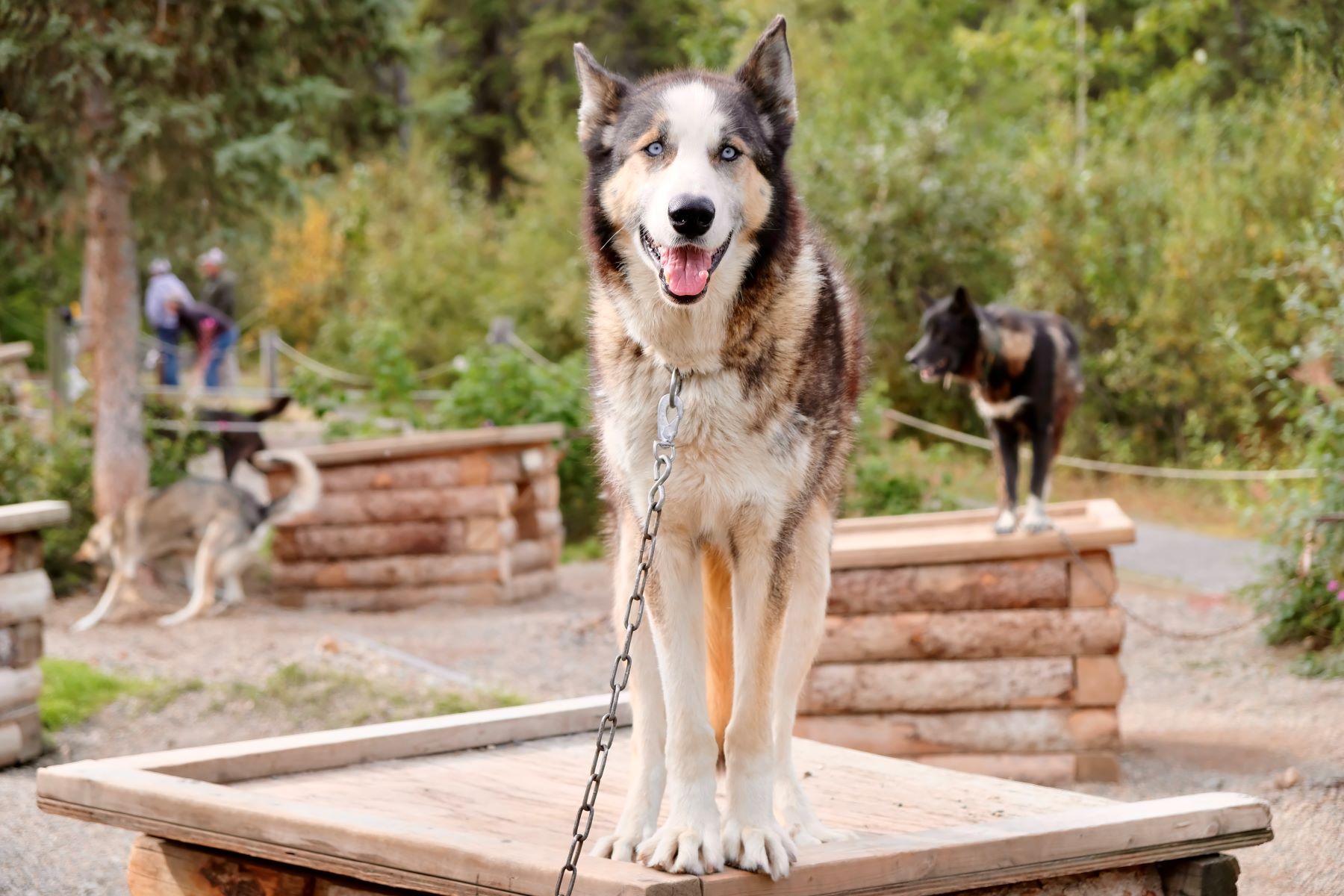
Flightseeing
Climbing Denali, the tallest mountain in North America and one of the world's seven summits, is a dream goal for many mountaineers. An easier - yet still dramatic - way to see the summit is through a flightseeing tour, with options for glacier landings. These flights depart near the park entrance or from the charming mountaineering town of Talkeetna, and are a fantastic way to take in the park’s spectacular sights from the air, especially if you don’t have time for a bus tour on the Park Road.

Denali National Park Lodging
Most visitors to Denali National Park stay at the many hotels, lodges, and cabins located near the park entrance in an area known as Denali Park. These accommodations typically provide shuttle service to the park and can arrange tours and other activities in the area. If you’d like to stay in the park, there are 6 designated campgrounds, from Riley Creek Campground at the park entrance to Wonder Lake Campground near the end of the road. Half of the campgrounds are tent-only and accessible only by bus and the other half are open to both tents and RVs. All are reservable in advance.

Backcountry Lodges in Denali
A stay at a backcountry lodge is an unparalleled, possibly once-in-a-lifetime adventure. There are four privately run lodges in Denali National Park, and each is only accessed by air during the Park Road construction, and accessible by bus during normal Park Road operations. These remote lodges offer rustic yet comfortable accommodations, allowing you to disconnect from the modern world and connect with nature in the pristine wilderness of the Alaska Range.
These full-service, all-inclusive lodges are set in stunning, remote locations at the end of the park road in Kantishna and include meals, comfortable amenities, and activities like hiking and wildlife viewing right from their front doors. You’ll find a myriad of activities at each lodge, including guided hikes across rugged terrain, wildlife viewing excursions to spot grizzly bears, wolves, and caribou, and educational programs led by naturalists. Canoeing, fishing, gold panning, and biking are all available as well.

Getting to Denali National Park
The three main ways to get to Denali National Park and Preserve are by car, train, or bus. The closest major cities to the park are Fairbanks, 120 miles north of the park, and Anchorage, 240 miles south of the park. There are also several smaller communities near the park with lodging, tours, and other services, including Healy, Cantwell, Nenana, and Talkeetna.
The entrance to Denali National Park is located at Mile 237 of the George Parks Highway. Driving yourself to Denali is a fantastic way to take in the many sights and charming towns along the way. If you’d rather sit back and relax, the Alaska Railroad offers service to Denali from any stop along the railbelt and drops you off right at the park entrance. Private bus tour operators also offer bus transportation from Anchorage and Fairbanks.

When to Visit Denali National Park
The peak time for visiting the park is mid-May through mid-September, when the park buses and other amenities are operational, wildlife viewing opportunities are at their peak, and weather conditions allow for more activities like hiking, biking, backpacking, and camping.
If you’re prepared for cold, snowy conditions and dazzling beauty, visiting Denali National Park in winter is a unique and rewarding experience. The Park Road and most of the visitor services are closed in winter, though the Murie Science & Learning Center, which serves as Winter Visitor Center, and Sled Dog Kennels are open. Once the snow falls, popular winter activities include cross country skiing, fat tire biking, and snowshoeing along the Park Road and designated winter trails near the park entrance. With long, dark nights and little light pollution, Denali is also a good location for northern lights viewing in winter.
Find tips for exploring Denali National Park.

Denali National Park History
Generations of Koyukon Athabascans lived in and traveled through what is now the park for thousands of years. The first permanent non-Alaska Native settlement was established in 1905, when a gold rush gave birth to the town of Kantishna. A year later, naturalist and noted hunter Charles Sheldon was stunned by the beauty of the land and horrified at the reckless abandon of the miners and big-game hunters. Sheldon returned in 1907 and traveled the area with guide Harry Karstens in an effort to set up boundaries for a proposed national park. Sheldon was successful and the area was established as Mount McKinley National Park in 1917, with Karstens serving as the park's first superintendent. It was designated an international biosphere reserve in 1976.
As a result of the 1980 Alaska National Interest Lands Conservation Act, the park was enlarged to more than 6 million acres and renamed Denali National Park and Preserve. In 2015 President Barack Obama officially renamed Mt. McKinley to Denali, its Athabascan given name, meaning “the Tall One.” Denali National Park and Preserve now comprises an area slightly larger than the state of Massachusetts and is ranked as one of Alaska's top attractions.
Learn more about lodging and things to do near the Denali Park Entrance.
For more information, visit the Denali National Park and Preserve website.

Plan Your Trip
The Alaska Travel Experts for 25 years, Alaska Tour & Travel specializes in custom vacations to Alaska's most spectacular destinations. Our...
Combine a cruise to Alaska with a land-package or add day tours in your ports of call! Visit Denali National Park, take a ride on the Alaska...
Thank you for your interest in staying at Ridgetop Cabins during your visit to Denali National Park --- we are confident you will find our scenic...
From breathtaking scenic coach tours to the iconic Alaska Rail Road and self-drive packages – we have every option covered to complete your dream...
Fly Out Travel takes the guesswork out of planning a trip to Alaska. We provide first-hand, honest and un-biased travel information with one goal...
'Best Trip Every Trip' We are an adventure company that offers a variety of hiking, rafting and pack-rafting options just outside Denali National...
Denali Backcountry Adventure will not be running in 2023. Visit our website and subscribe to our email list for the latest updates on what we’ll...
Sightseeing for the history buff, the foodie, the geologist, the dog lover, the armchair adventurer -- with Alaska Tour & Travel you can search...
Explore our extensive range of Alaska Train Trips and start dreaming of massive glaciers, majestic mountains and pristine national parks of...
Denali Hostel & Cabins offers you a truly special experience at an affordable price. We have a variety of charming accommodations just outside...
Tonglen Lake Lodge is located 7 miles south of the main entrance to Denali National Park in a secluded wilderness setting away from the crowds...
Join us on our Denali: Discovery Adventure for a taste of the best of Alaska in the summer. This incredible Alaska, small-group summer tour...
Fly with the original flightseeing company in Denali for your best odds of seeing The Mountain while circling it "face to face." Passengers on...
Make Denali Riverside Cabins your stay and play basecamp. Enjoy a front row seat at the closest hotel to Denali National Park. Self-check-in Co...
The Real Alaska Adventure Company provides all inclusive, fully immersive trips primarily on the Kenai Peninsula. Trips include white water...
Discover Denali provides information for tourism and recreation in the areas surrounding Denali National Park. Let us help plan your trip...
Denali Princess Wilderness Lodge offers the best accommodations near the Denali National Park entrance. The lodge features river and park views...
See Alaska in style aboard the newest luxury dome train service between Anchorage, Talkeetna, Denali Park, and Fairbanks. Private dome cars have...
Summit Denali! Don't stop until you reach the top! The most extensive flight tour of North America's highest peak. View the mountain and Denali...
The McKinley Chalet Resort is situated in the heart of the Denali Canyon on the banks of the Nenana River just minutes from the entrance to...

Local Climate & Weather
For Alaska's day-to-day weather, it’s best to plan for a bit of everything. Learn more about weather in this area.
Travel Inspiration
#TravelAlaska
#TravelAlaska
 @rehmat.orakzai
@rehmat.orakzai
 @rehmat.orakzai
@rehmat.orakzai
 @realfamilytravelswithsara
@realfamilytravelswithsara
 @rehmat.orakzai
@rehmat.orakzai
 @time_to_go_adventure
@time_to_go_adventure

